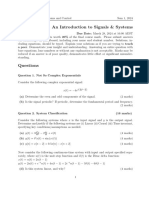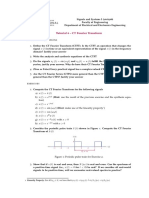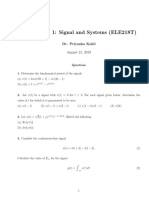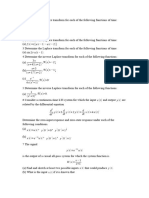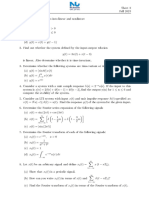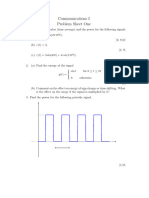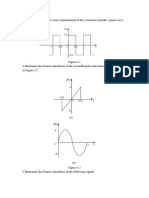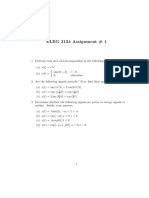Assignment 6
Uploaded by
altoprimeAssignment 6
Uploaded by
altoprime( )
1. Identify which of these functions has a complex CTFS c g k for which 1) Re c g k = 0 for all k,
( )
or 2) Im c g k = 0 for all k, or 3) neither of these conditions applies.
(a) g ( t ) = 18cos ( 200p t ) + 22cos ( 240p t )
(b) g ( t ) = -4sin (10p t ) sin ( 2000p t )
t 1
(c) g t tri 10 t
4
2. A system is excited by a signal x ( t ) = 4 rect ( t / 2 ) and its response is
( ) ( )
y ( t ) = 10 1- e-(t+1) u ( t +1) - 1- e-(t-1) u ( t -1) .
What is its impulse response?
j2p f
3. A signal x ( t ) has a CTFT X ( f ) = .
3 + jf /10
(a) What is the total net area under the signal x ( t ) ?
t
(b) Let y ( t ) be the integral of x ( t ) , y t x d . What is the total net area under
y(t ) ?
4. Find the numerical values of the literal constants in the following CTFT pairs.
(a)
(b)
(c)
(Hint: Use the definition of the continuous-time periodic impulse and
continuous-time impulse properties.)
(d)
5. An LTI continuous-time system is described by the differential equation 2 y ( t ) + 5y ( t ) = x ( t ).
Which is the correct description of this systems frequency response?
(a) The system attenuates low frequencies more than high frequencies.
(b) The system attenuates high frequencies more than low frequencies.
(c) The system has the same effect on all frequencies.
You might also like
- Question Bank_231ECC304T_Signals and systems_Answer key_Unit3No ratings yetQuestion Bank_231ECC304T_Signals and systems_Answer key_Unit316 pages
- Transmission of A Signals Through Linear SystemsNo ratings yetTransmission of A Signals Through Linear Systems12 pages
- Chapter 5 - The Fourier Transform: Selected SolutionsNo ratings yetChapter 5 - The Fourier Transform: Selected Solutions43 pages
- Tutorial 6 - CT Fourier Transform (Exercises)No ratings yetTutorial 6 - CT Fourier Transform (Exercises)2 pages
- Tutorial 6 - CT Fourier Transform: Linearity Property: C, we have that ¯α100% (1)Tutorial 6 - CT Fourier Transform: Linearity Property: C, we have that ¯α2 pages
- Exercises For Signals and Systems (Part Four)No ratings yetExercises For Signals and Systems (Part Four)3 pages
- Information and Communication Assignment 1No ratings yetInformation and Communication Assignment 13 pages
- Principles of Communication Systems Homework 1No ratings yetPrinciples of Communication Systems Homework 13 pages
- Midterm Exam: Signal and System-100 Minutes Code 0010No ratings yetMidterm Exam: Signal and System-100 Minutes Code 001016 pages
- Exercises For Signals and Systems (Part Three)No ratings yetExercises For Signals and Systems (Part Three)6 pages
- Problem Set No. 6: Sabancı University Faculty of Engineering and Natural Sciences Ens 211 - SignalsNo ratings yetProblem Set No. 6: Sabancı University Faculty of Engineering and Natural Sciences Ens 211 - Signals6 pages
- Laplace Transform _ DPP-04 (of Lec- 08 & 09) __ Shreshth GATE 2025 Electrical Weekday (Hinglish)No ratings yetLaplace Transform _ DPP-04 (of Lec- 08 & 09) __ Shreshth GATE 2025 Electrical Weekday (Hinglish)3 pages
- The Fast Fourier Transform: (And DCT Too )No ratings yetThe Fast Fourier Transform: (And DCT Too )36 pages
- Complete LTI System Analysis in 2.5 Hours With AIR 1 - DPP-05No ratings yetComplete LTI System Analysis in 2.5 Hours With AIR 1 - DPP-054 pages
- Student Solutions Manual to Accompany Economic Dynamics in Discrete Time, secondeditionFrom EverandStudent Solutions Manual to Accompany Economic Dynamics in Discrete Time, secondedition4.5/5 (2)














